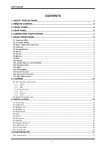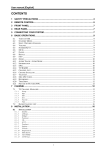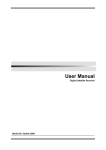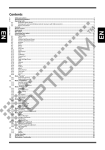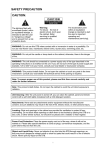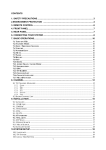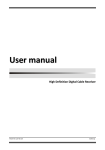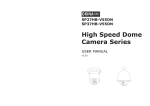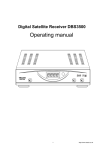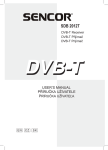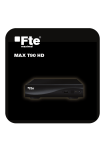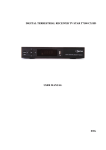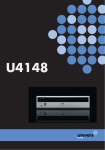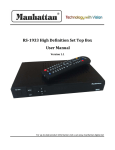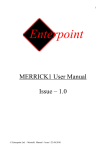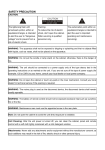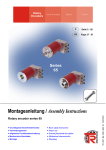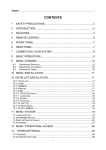Download User manual
Transcript
User manual [English] DVB-S RECEIVER TVSTAR S-3000 USB PVR USER MANUAL CONTENTS 1 SAFETY PRECAUTIONS ................................................................................................... 3 2 REMOTE CONTROL........................................................................................................... 5 3 FRONT PANEL ................................................................................................................... 7 4 REAR PANEL ...................................................................................................................... 7 5 CONNECTING YOUR SYSTEM ......................................................................................... 7 6 BASIC OPERATIONS ......................................................................................................... 9 6.1 TURN ON STB ................................................................................................................ 9 6.2 STANDBY MODE ............................................................................................................. 9 6.3 NEXT / PREVIOUS CHANNEL ............................................................................................ 9 6.4 VOLUME ......................................................................................................................... 9 6.5 NUMBER KEYS................................................................................................................ 9 6.6 MUTE ............................................................................................................................. 9 6.7 PAUSE ........................................................................................................................... 9 6.8 RECALL .......................................................................................................................... 9 6.9 FAV ............................................................................................................................... 9 6.10 ZOOM ........................................................................................................................... 10 6.11 AUDIO TRACK / AUDIO MODE ........................................................................................ 10 6.12 INFORMATION ............................................................................................................... 10 6.13 EPG ............................................................................................................................ 10 6.14 TV/RADIO ................................................................................................................... 10 6.15 CHANNEL LIST .............................................................................................................. 10 6.16 CHANGE SATELLITE ...................................................................................................... 10 6.17 TELETEXT..................................................................................................................... 10 6.18 MULTIPICTURES ........................................................................................................... 10 6.19 RECORDING .................................................................................................................. 11 6.20 TIME SHIFT ................................................................................................................... 11 6.21 PICTURE IN PICTURE (PIP) ............................................................................................ 12 7 CHANNEL.......................................................................................................................... 12 7.1 7.1.1 7.1.2 7.1.3 7.1.4 7.1.5 7.1.6 8 TV CHANNEL MANAGER ................................................................................................ 13 Group ................................................................................................................................................. 13 Skip .................................................................................................................................................... 13 Edit..................................................................................................................................................... 13 Sort .................................................................................................................................................... 15 Favorite .............................................................................................................................................. 15 Find .................................................................................................................................................... 16 RADIO CHANNEL LIST .................................................................................................... 16 7.2 INSTALLATION................................................................................................................. 16 8.1 INSTALLATION............................................................................................................... 16 8.2 CA SETTING ................................................................................................................. 19 9 SYSTEM ............................................................................................................................ 19 9.1 9.2 LANGUAGE ................................................................................................................... 19 TV SYSTEM .................................................................................................................. 20 1 User manual [English] 9.3 LOCAL TIME SETTING .................................................................................................... 21 9.4 TIMER .......................................................................................................................... 21 9.5 STARTUP CHANNEL ....................................................................................................... 22 9.6 CHANNEL PLAY TYPE..................................................................................................... 22 9.7 OSD SETTING .............................................................................................................. 23 9.8 PARENTAL LOCK ........................................................................................................... 23 10 TOOLS ............................................................................................................................... 24 10.1 INFORMATION ............................................................................................................... 24 10.2 SATELLITE GUIDE .......................................................................................................... 24 10.3 DEFAULT VALUE............................................................................................................ 25 10.4 SOFTWARE UPGRADE.................................................................................................... 26 10.5 UPGRADE BY USB ........................................................................................................ 26 10.6 BACKUP TO USB........................................................................................................... 27 11 GAME ................................................................................................................................ 27 11.1 TETRIS ......................................................................................................................... 27 11.2 SNAKE.......................................................................................................................... 27 11.3 OTHELLO ...................................................................................................................... 28 12 USB .................................................................................................................................... 28 12.1 RECORD MANAGER ....................................................................................................... 28 12.2 HDD INFORMATION ....................................................................................................... 28 12.3 HDD FORMAT ............................................................................................................... 29 12.4 PVR SETTING ............................................................................................................... 29 12.5 FILE LIST ...................................................................................................................... 29 12.6 USB SPEED TEST ......................................................................................................... 30 12.7 REMOVE USB DEVICE ................................................................................................... 30 13 INTERNET ......................................................................................................................... 30 13.1 NETWORK LOCAL SETTING ............................................................................................ 30 13.2 HTTP UPGRADE ............................................................................................................ 31 13.3 FTP UPGRADE.............................................................................................................. 31 13.4 FTP ............................................................................................................................. 31 14 TROUBLE SHOOTING ..................................................................................................... 32 15 SPECIFICATIONS............................................................................................................. 33 15.1 15.2 15.3 15.4 15.5 15.6 GENERAL...................................................................................................................... 33 A/V MODE .................................................................................................................... 33 MICROPROCESSOR & MEMORIES ................................................................................... 33 POWER & ENVIRONMENT CONDITION ............................................................................. 33 PHYSICAL SPECIFICATION .............................................................................................. 33 CONNECTION ................................................................................................................ 33 2 User manual [English] 1 Safety precautions CAUTION: The lightning flash with arrowhead symbol, within an equilateral triangle, is intended to alert the user to "dangerous voltage" and to prevent from a risk of electric shock. Warning: To reduce the risk of electric shock, don't open the cabinet. Refer servicing to qualified personnel only. The exclamation point within an equilateral triangle is intended to alert the user to important operating and maintenance (servicing). WARNING: Do not use this STB where contact with or immersion in water is a possibility. Do not use near flower vase, washbowls, kitchen sinks, laundry tubs, swimming pools, etc. WARNING: Do not put the candle or lamp stand on the cabinet; otherwise, there is the danger of fire. WARNING: The unit should be connected to a power supply only of the type described in the operating instructions or as marked on the unit. If you are not sure of the type of power supply (for example, 120 or 230 V) to your home, consult your local dealer or local power company. WARNING: This product install diodes. Do not open the cabinet or touch any parts in the inner mechanism. Consult your local dealer for technical service if the opening is required. Note: To ensure proper use of this product, please read this User manual carefully and retain for further reference. Note: This product install diodes. Do not open the cabinet to avoid the unit direct exposure to radiation. Unit Cleaning: After the unit power is turned off, you can clean the cabinet, panel and remote control with a soft cloth lightly moistened with a mild detergent solution. Attachments: Never add any attachments and/or equipment without the manufacturer consent; as such additions may result in the risk of fire, electric shock, or other personal injury. Locating: Slots and openings in the cabinet are provided for ventilation to protect it from overheating. Do not block these openings or allow them to be blocked by placing the STB on a bed, sofa, or other similar surface, nor should it be placed over a radiator or heat register. Power-Cord Protection: Place the power-supply cord out of the way, where it will not be walked on. Please take special attentions to cords at plugs, convenience receptacles, and the point where they exit from the unit. 3 User manual [English] Object and Liquid Entry: Never put objects of any kind into this STB through openings, as they may touch dangerous voltage points or short-out parts that could result in a fire or electric shock. Never spill any liquid on the STB. Note: Moisture may be formed on the lens In the following conditions: when the unit is suddenly moved from a cold environment or an air-condition room to a warm place. immediately after a heater has been turned on. in a steamy or very humid room. If the moisture forms inside the unit, it may not operate properly. To correct this problem, turn on the power and wait about two hours for the moisture to evaporate. Parts Replacement: When the unit parts need to be replaced, user should make sure the service technician use the replacement parts specified by the manufacturer or having the same characteristics as the original part. Unauthorized replacement may put the unit In the risk of fire, electric shock or other hazards. Safety Check: After all the maintenances and repairs are done, user is required to request the service technician to conduct the overall safety check to ensure the machine is In the proper condition. 4 User manual [English] 2 Remote Control POWER To switch your receiver on from standby or standby to on. MUTE Used to enable or disable the audio NUMERIC KEYS Used to select channels or enter programming parameters (TV / RADIO) Receiver switches between TV and Radio mode. (ZOOM) Press key select zoom times, from X1 to X16. (PREVIOUS) Return to the previous menu or status. (AUDIO) Audio channels setup, to select audio mode; Left, Right , Stereo, Mono. TV/SAT Receiver switches between TV and receive mode. (INFORMATION) To display channel status or various program information of current service. EPG(Electronic Program Guide) Display the Programs guide on screen when available. MENU Displays the Main Menu on the screen, or return to the previous menu or status. EXIT Cancel the user selection and return to the viewing mode from a menu. OK To select menu option, or to updated on entry. <,> KEY To adjust volume level, or to move cursor left or right in the menu. ^,v KEY To change channels, or to move cursor up or down in the menu. P+/PTo move up the cursor to the next or previous page in the menu or channel list. Red Key Has different functions per menu. PIP To start PIP function. Teletext (GREEN KEY) Shows teletext information of the current channel supports. Subtitle(YELLOW KEY) Subtitle Display. (BLUE KEY) Multi channels display. You can choice the desire channel use <,> ^,v and press ok confirm. UHF In case your TV is connected through RF Modulator (UHF), select output channel number between CH21 and CH69 with up and down key. (FIND) Use to prompt find channels sort by character. TIMER Press timer key you can setup up the Standby time. Press the “ ” button can swap the PIP’s window in PIP function. P/N Press P/N button to switch the display mode among "AUTO", "PAL","NTSC" SAT 5 User manual [English] Display satellite list. FAV(FAVORITE) To set receiver to the favorite server mode, display the favorite channel. Archive Press this button to enter the File Manager menu directly. TMS(Time Shift) Press this button to display Time Shift info bar . Play To play the MP3, JPEG or recording file. Stop To stop MP3/JPEG player, recording file , Time Shift, or playback. PAUSE Used to select the freeze function. Press once to freeze the screen picture. Record To start recording. Fast Backward To start Fast Backward function. Fast Forward To start Fast Forward function . Slow Backward To start Slow Backward function . Slow Forward To start Slow Forward function 6 User manual [English] 3 Front panel POWER: To switch the receiver power on/stand by VOL^, v KEY: To adjust volume level, or to move cursor left or right in the menu CH ^, v KEY : To change channels, or to move cursor up or down in the menu Remote Sensor: Detects infrared signal from remote control unit Card slot: One slot CA Interface for Conax. lnsert the smart card chip side up! Display(4-Digit/7-Segment ): Indicates operating status of receiver Power Led: Lights up while the receiver is power on Signal Led: When receiving signal is strong, the signal led is lighted. 4 Rear Panel Please refer to the diagram above for all possible connections of your receiver Do not connect the unit to the mains socket until all other connections have been made and checked. LOOP: This enables the connection of another receiver. 13/18V 500mA MAX LNB IN: This port is to connect the coaxial cable from LNB of your Dish. VIDEO OUT: This RCA connector is used to connect any external video. 0~12V: This is used to Connect 12V to an external 0V/12V switch. S/PDIF: Digital Audio interface, connect to AV amplifier S/PDIF input terminal. AUDIO R/L : These RCA connectors are used to connect any external audio amp or system. RS 232C SERIAL PORT: This is used to connect your receiver to a computer through a serial cable. TV : This is used to connect your TV through SCART cable. USB: USB 2.0 Host, connect to USB hard disk, or flash disk Ethernet: Network port, you can get a new software updates from this port. (optional) Power ON/OFF SWITCH: To switch ON/OFF the receiver power supply. RF OUT: This enables the connection of another receiver. RF IN : This port is to connect the coaxial cable from terrestrial antenna. 5 Connecting Your System There are three ways to connect the receiver to your existing TV system. We recommend using one of the following cases for the best result: 1. Connect one end of SCART cable to the TV (SCART) jack on the back of the receiver and the other end to a SCART jack on your TV. 2. Connect one end of RCA cable to the RCA jack on the back of the receiver and the other end to a RCA jack on your TV. 3. If your TV doesn't have a RCA jack, connect one end of RF cable to the TV on the back of the receiver and the other end to a RF input jack on your TV. 7 User manual [English] Finally connect the coaxial cable from the LNB to the LNB IN jack on the receiver. Connecting with External Audio / Hi-Fi System To connect any external Audio Hi-Fi system, the receiver has been provided with two RCA connectors at the back of the receiver marked with Audio L and R. Connect an RCA stereo cable from the AUDIO L, R jacks on the back of the receiver to the LINE, AUX, SPARE OR EXTRA input jacks on your Hi-Fi System. Connecting with Motorized System (DiSEqC 1.2) Connect one end of your coaxial cable to the LNB IN connector on the receiver and the other end to the REC or Receiver connector on the DiSEqC 1.2 motor. Connect the coaxial cable from the LNB to the LNB connector on the DiSEqC 1.2 motor. All our receivers are designed to be DiSEqC 1.0 and DiSEqC 1.2 compatible. This allows multiple antennas to be connected to the receiver at the same time. If you have two or more fixed antennas or LNBs, then we recommend you use a DiSEqC 1.0 switch. Connect the coaxial cable from the first LNB to the LNB 1 or LNB A input connector of the DiSEqC switch. Do the same for any other LNBs that you have. Connect one end of a coaxial cable to the RF output connector of the DiSEqC switch, connect the other end to the LNB IN socket on the receiver. To the digital receiver, you can connect either a single satellite antenna directly or LNB of multi-feed equipment. 8 User manual [English] 6 3 Users can also disconnect the device’s main power to end the Standby mode. Basic Operations 6.1 6.3 Turn on STB In full screen, press keys Channel Up/Channel Down to change channel. Firstly, press the Device’s Main Power to turn on the unit. If the STB is used for the first time, it will play the first channel from the default Channel List. Otherwise, it will play the last channel before being turned off. 6.4 Volume In full screen, press keys Volume +/Volume to adjust volume. 6.5 Frequently Asked Question Q: The power of my STB has been turned on and not in Standby mode, but the TV screen showed nothing: Number Keys In full screen, use number keys and press OK on the Remote Control Unit to change channels. 6.6 A: Make sure the TV set has been set to the correct video input (not the TV channels). For example, if you have connected the unit with the Video1 input of the TV set, the TV set has to be switched to Video1. Mute 1 Press key [ ] to mute the sound and the screen will show up. 2 Press key Mute again to restore sound. 6.7 Pause 1 In playing mode, press key Pause [ II ] , and the picture will pause, but the sound of the channel will still remain. 2 Press key Pause [ II ] again, and the screen’s picture will skip over to the current playing picture, and the sound of the channel will correspondingly play. Q: The power of my STB has been turned on and not in Standby mode, but the TV screen showed nothing except “No Signal” message. A: This means the channel you select has no signal. There could be several causes: 1 The channel which you select is not in your allocated satellite. The solution is to change the channel. 2 The signal of current TV channel is too weak. Try to switch to other strong signal channels. If the problems still exist, please consult your local dealer or other professionals for technical service. 3 You have used the Dual LNB, and need Modify LNB Type 6.2 Next / Previous Channel 6.8 Recall Press key Recall [ ] will directly switch to the previous channel that you watch before current channel. 6.9 FAV 1 In full screen, press key [FAV] , and it will display a window of “Favorite Group on the left of the screen like below. 2 In the window of “Favorite Group”, you can move highlight by pressing keys Channel Up/Channel Down ,then press OK key to set favorite channel you choose. 3 Keys ◄,► and ▲,▼ can implement the Standby Mode 1 Pressing Key Power [ ] can enter the Standby mode. 2 In Standby mode, pressing Key Power again can move back to the unit and go on playing the previous channel. 9 User manual [English] “Page up/Page down” function. 4 The favorite group is the favorite channels you have marked in Menu “TV channel list”. Please refer to Favorite. 5 Press Exit key to draw back from “Favorite” menu. ? Frequently Asked Question Q: Why the screen displays “No Favorite Channel” ,after pressing FAV key? In full screen, pressing key Info can open information screen. The window shows the parameters of current channel. 6.13 EPG 1 The STB has an Electronic Program Guide (EPG) to help you select channels through all the possible viewing options. The EPG supplies information such as channel lists and time starting/ ending for all available channels. Press key [EPG] to display EPG screen. 1 Pressing [▲,▼] key can switch between channels, 2 Pressing [green] key will display more details about currently shown channel 3 Pressing [yellow] key will display more details about next program displayed on current channel 3 In EPG menu, press key Exit to close EPG screen. A: It is because you haven’t set any channels as “favorite channel”. Please refer to Favorite 6.10 Zoom 6.14 TV/RADIO In TV mode, pressing key TV/RADIO [ ] can switch to Radio mode. In Radio mode, pressing key TV/RADIO can switch to TV mode. 1 The key Zoom [ 0/ ]allows you to magnify a certain area on the images and the current screen will show. 2 Press key Zoom again, the image will enlarge rotate as x1, x2, x4, x6, x8, x12, x16. 3 In “x2 ~ x16” image, ◄,►/▲,▼keys are to move the inner yellow square you want to see. 4 In zoom mode, press Exit to close “Zoom” window. 6.15 Channel List 1 In full screen, pressing [OK] key can enter “Channel List”, please refer to TV Channel List for detailed information. 2 In “Channel List” menu, press OK key to draw back to full screen. 6.16 Change Satellite 6.11 Audio Track / Audio Mode 1 In full screen mode , pressing key [SAT] can open installed satellite list and switch satellites. 2. In full screen, pressing key [OK] and ◄,► can switch satellite directly. 1 In full screen, pressing key Audio can open the “Audio Mode” window on the right side of the screen. 2 You can move highlight by pressing ▲,▼ keys and switch each selection by pressing ◄,► keys 6.17 Teletext In full screen mode press green key to enter the teletext. Input proper teletext site by numeric keys. 6.12 Information 6.18 MultiPictures 10 User manual [English] In full screen, press key [ MultiPictures mode like below: ] to enter the Press " " button to display the record info bar when you recording. 1 In MultiPictures mode, the screen will display 9 channels’ preview window (static) from the current channel. And only the highlighted preview program can play normally. 2 Press ◄,► ,▲,▼ �keys can move highlight among each preview program or press P+/P- keys to the next or previous 9 channels’ preview window, and only the highlighted preview program can play normally. 3 When the highlight moves to the preview program that you want to play, you can press key OK to enter the full screen play. Press " " button again to setting the record time. You can press " " button to pause the 6.19 Recording video, and can save the picture to flash by Connect USB device first. Make sure you press " P+ " button when the video is connected USB cable to USB. paused. After connecting USB device correctly and recognizing it by receiver you will see on the " or " " button to Fast Backward or Fast Forward. screen for a moment message: “USB Mount Success”. You can press " " or " " button to Slow Backward or Slow Forward. You can press " You can press " " button to start record Press “left" or "right" button to jump to different position, then press "OK" button to function, as following picture: confirm. Press " " button to stop the recording. 6.20 Time Shift 11 User manual [English] Connect the USB HDD, and enable the Time Shift function in the menu "Main Menu/ USB/ PVR Setting/Time Shift". It will start the Time Shift function automatically after you switch the program, and when you press the "TMS" button the Time Shift info bar will displayed as the following picture: 1. Press PIP [red] key to start PIP function. 2. At PIP screen, press key to exchange main-picture with sub-picture. 3. Press [Blue] key to move the position of sub-picture. 4. press [OK] key to display the PIP list of sub-picture You can press " " button to pause the video, and can save the picture to flash by 7 Channel press " P+ " button when the video is When you press[Menu]key to enter menu, there paused. will display the picture like below: You can press " " or " " button to Fast Backward or Fast Forward. You can press " " or " " button to Slow Backward or Slow Forward. Press “left" or "right" button to jump to different position, then press "OK" button to confirm. Press " " button to exit the playback. 6.21 Picture In Picture (PIP) 1 Press[Up/Down]key to select menu pages among Channel, Installation, System, Tools, Game, USB and Intemet 2 Press[OK]key to enter the selected item. 12 User manual [English] 5 Press color key can implement the corresponding function in “Channel Manager”. 7.1.1 Group In “Channel” menu: 1 Press[Channel Up/Channel Down]key to select menu items among TV Channel Manager, Radio Channel Manager . 1 Press [Red] key can open the “Group” window 2 Press[OK]key to enter the selected item. 7.1 like above 2 You can press [Up/Down] key to move TV Channel Manager highlight and press [OK] key to select group. When you enter to “Channel List” menu, there 3 Press [Menu] key or [Exit] key to close “Group” list. will display the screen like below. 7.1.2 Skip 1 You can move highlight by press[Channel Up/Channel Down]key and press[OK]key to 1 In preview the current highlighted program in the “TV Channel Manager” menu, press [Green] key can make a “skip mark” in the right side preview window. right side of the highlighted channel. 2 You can press[Page Up/Page Down]key to 2 After save and exit “TV Channel Manager” implement the Page Up/Page Down function. menu, the channel will be skip while user 3 You can use [Volume Up/Volume Down]key to change channel in the full screen. switch “Program Group”. 7.1.3 Edit 4 You can press[Menu]or[Exit]keys to enter full Press [Yellow] key, it will show input password screen playing mode. dialog. If the password is correct, it will open the 13 User manual [English] window like below. The default password is number, and the next three items will show “0000”. up corresponding parameters. 7.1.3.1 Delete 3 In “Name” item, press[OK]key can display the keypad, and you can edit new name here for selected channel. 4 In “Video PID”, “Audio PID” and “PCR PID” items, you can use the number key directly to modify corresponding parameters of the items. 5 After modification, move highlight to “Save” item and press[OK]key, can save parameter and exit “Edit” mode. Otherwise, move 1 In this menu, press [Red] key can make a highlight to [Exit]item and press[OK]key can exit “Edit” mode and delete mark in the right side of the highlighted won’t save any modification. channel. 2 Press [Red] key again can cancel the deleted 7.1.3.3 Edit mark on the current channel. If you press[Yellow] key, it will show the window 3 When exit the menu, it will ask you whether to like below: save the change. Select “Yes” to save the change. 7.1.3.2 Create If you press[Green] key, it will display create window like below: 1 On the “Name” item, press[OK]key can display keypad to edit the name of selected channel. 2 On the “Video PID”, “Audio PID” and “PCR PID” items, you can input numerals to 1 In “Satellite” item, press[OK] key can modify the according item’s value. display satellite list and you can select a 3 After modification, move highlight to “Save” satellite that you want to setting. item 2 In “TP Index” item, you can press[Volume Up/Volume Down]key can switch and press[OK]key can save the modified value and TP exit “Edit” mode. Otherwise, move highlight to [Exit]item and 14 User manual [English] press[OK]key can exit “Edit” mode and won’t save any modification. 7.1.3.4 Lock 1 Press [Blue] key can open the “Sort” window like above. There are five kinds of sorting Press [Blue] key can make a “lock mark” in the ways. You can press[Channel Up/Channel Down]key to move highlight and right side of the highlighted channel. After save press[OK]key to confirm you selection and exit the menu, STB will request you to input 2 The five kinds of sorting way are: the password while you want to watch the Default: Sorting by scanning result. locked channel. FTA/$: 7.1.3.5 Move Sort channel by free and scramble sequence. Free channel will be displayed at the beginning of channels list and scramble channel will be at the end of channels list Lock: Accumulated all locked channels and list in the front of TV Channel List. Name (A-Z): Sorting in Alphabetical Order, ignore “$” symbol. Name (Z-A): Sorting in Alphabetical Order, ignore “$” symbol. 1 In this menu, press [White] key can make a 7.1.5 Favorite moving mark in the right side of the highlighted channel. 2 Press [Up/Down] key to move the channel 3 Press [OK] key to put the channel to the target place. 4 When exit the menu, it will ask you whether to save the change. Select “Yes” to save the change. 7.1.4 Sort 15 User manual [English] 1 Press [White]key can open the “Favorite” 7.2 window like above Basically, the operation of “Radio Channel 2 You can move highlight between 8 favorite groups by press[Channel Radio Channel List Manager” is same as “TV Channel Manager”, Up/Channel but there is one point different: In “Radio Down]key and press[OK]key to make a Channel Manager” mode, there is no video favorite mark in the right side of the information, so it will always display Radio’s selected Favorite group. logo in the right side preview window. 3 Press[OK]key on the marked Favorite group can cancel the exist favorite mark. 8 4 In this menu, press[Red]key can display Installation the keypad, and you can edit new name 8.1 Installation here for selected Favorite group. When you enter to “Installation” menu, there will 5 After marking, press[Exit]key can back to display the screen like below: “TV Channel List” , there will show a favorite mark beside the marked channel. 7.1.6 Find 8.1.1 Satellite Satellite: Press[OK]key to enter the Satellite 1 Press[Find] list. key can open the “Find” window like above. You can press[Channel Up/Channel Down]key Down/Volume to move Up/Volume highlight and press[OK]key to input the selected symbol or letter into the dialogue. 2 After input each character, the program list on the left will search the channel according your input, and list the matched channel. 3 Press[Exit]key can close “Find” window and 1 You can press color key to add/edit/delete you can select channel from the channels satellite. Press [Page] key to page up or page list directly. down. 16 User manual [English] 8.1.2 In this LNB type item, press[Volume Up/ Volume Down]key can switch among “Standard”, “User” and “Universal” mode. For Example: If you use the Dual LNB, then you should select “User” option in “LNB Type” and set the correct frequency in LNB Type, then you can play the channel normally. 8.1.3 DiSEqC DiSEqC: You can use[Volume Up/ Volume Positioner: In “Positioner” item, you can press Down]key to switch options. There are several [Volume Up/ Volume Down]key to switch “OFF options for your selection: / DiSEqC 1.2 / USALS” Functions. Disable: without DiSEqC. 1/2, 2/2: two ports DiSEqC 8.1.5 1/4, 2/4, 3/4, 4/4: 4 ports DiSEqC You can use[Volume Up/ Volume Down]key to 1/8, 2/8… 8/8: 8 ports DiSEqC switch “ON / Off”. When this item is switched to 1/16, 2/16….16/16: 16 ports DiSEqC 8.1.4 22k “ON”, receiver will receive TV and radio input signal from 22K port. If the item is switched to Positioner “Off”, the receiver will receive all signal from 0K port. ! Notice When you choose LNB type “Universal”, you can not modify 22K. 8.1.6 0/12V You can use[Volume Up/ Volume Down]key to switch “0V / 12V”. When this item switches to “12V”, receiver will receive TV and radio input signal from 12V port. If the item switches to “0V”, the receiver will receive all signals from 0V 8.1.7 Toneburst In “Toneburst” item, you can press [Volume Up/ Volume Down]key to switch “Off/On” functions. 8.1.8 Polarity In “Polarity” item, [Volume Up/ Volume Down]key to switch “Auto / H / V” functions. 8.1.9 TP Scan When you enter to “TP Edit” menu, there will display the screen like below: 17 User manual [English] press[Volume Up/ Volume Down]key to switch it directly. 4 “Polarity” and “Scan Mode” are use for setting scans conditions, you can press[Volume Up/ Volume Down]key to select different mode. “Polarity” means you want to scan this TP in horizontal mode or in vertical mode. “Scan Mode” means you want to scan all channels or only scan free channels. 5 When you complete your modification, press [ red ]key, it will show up a dialog to ask you 1 In “Satellite” item, press[Volume Up/ Volume scan mode, program type ,Scan Typeand NIT Down]key to switch satellite that you want to Search on/off. After you set up, press [OK] scan or press[OK]key to enter satellite list for key to start scanning. selection. 6 In the “TP Scan” item, press [Exit] key to exit 2 In “TP Index” item, you not only can use the scanning and save the current [Volume Up/ Volume Down]key to select parameters. transponder but also can use[Add]and[Delete]functions. 8.1.10 Single Search When you press[green] key, it will display 1 Press [Red] key,, it will show up a dialog to “New Carrier” in “TP Index” item; You should ask you scan mode, program type , scan type set the parameters of “TP Frequency” and and NIT Search on/off. After you set up, “Symbol Rate” for this new transponder. The press [OK] key to start scanning. parameters of “TP Frequency” and “Symbol 2 Press [White] key into the blind scanning Rate” can set by number keys. The available immediately. range are “3000~13450 MHz” and “1000~45000Ks/s”. 8.1.11 Multi Search When you press[yellow] key, there will show When you Press [Green] key, you will see the up a warning message for reminding whether screen like below: you will delete the current transponder or not. If you select “Yes”, the current transponder will be deleted, and the total account of transponder will reduce 1 correspondingly. When you press [Blue] key, there will show up a warning message for reminding whether you will delete all transponders or not. If you select “OK”, all transponders will be deleted. 3 For the existed transponder, you also can use number keys to modify the parameters of “TP Frequency” and “Symbol Rate” or 18 User manual [English] [left/right] key to setting the message display You can press [ok] button to select one or 1 more satellites and press [red] button. it will time. show up a dialog to ask you scan mode, program type, scan type and NIT Search 9 System on/off. After you set up, press [OK] key to When you enter to “System ” menu, you will see start scanning. the screen like below: Press [green] button to edit the name and 2 longitude of the select satellite. 3 Press [yellow] button to add a new satellite. 4 Press [blue] button to delete a currently selected satellite 8.2 CA Setting Depending on your receiver version, we provide one CA slot for user to use. Receiver has build in smart card module with CONAX system. By using cards in this system provided by operators, it is possible to watch many In “System ” menu: scrambled channels coded in this system. This menu shows detailed information about card 1 Press[Channel Up/Channel Down]key to inserted into card reader module. It allows select menu items among Language, TV inserted according to help messages visible on System, Local Time Setting, Timer, Startup Channel ,Channel Play Type, OSD Setting, the bottom of the screen. Parental Lock. 2 Press[OK]key to enter the selected item. 9.1 Language When you enter to “Language” menu, you will see the screen like below: Note: All information showed in this menu and submenu are coming from inserted card. In case if anything is wrong, it could be card problem. After inserting the card correctly at any time, a message-box will show on the screen with message about detecting Language: press [Volume Up/ Volume Down] the card, in "card info" menu all available key to select languages, the selections of information will be displayed. You can press languages include: English, Russian, German, 19 User manual [English] Greek, French, Italian, Spanish, Turkish, Portuguese, Arabic,Polish etc. 1 First Audio: Some channels have more than one audio language for choosing; by this function you can set the first audio for this channel. If the playing channel has the same audio as the “First Audio” you set, system will play this audio language as default. If the channel hasn’t the suited audio language, then the system will compare automatically with second audio language. The selections 1 Display Mode is use for switching the of audio languages include: English, Russian, German, Greek, French, Italian, Spanish, Turkish, screen-displaying mode. Now we provide Portuguese, Arabic,Polish etc.. below options: Auto / PAL / PAL-M / PAL-N / Second Audio: If the channel has no correspond NTSC . You can press [Left/Right] key to audio with “First Audio” but have corresponded select each mode circularly. 2 Aspect Mode is used for switching the screen audio with “Second Audio”, system will play the second audio language as default. If no audio aspect ratio mode. Now we provide below language corresponds with the “Second Audio”, options: then the default language of current channel will press [Left/Right] key to select each mode be played automatically. The selections of audio circularly. 4:3 PS / 4:3 LB / 16:9. You can 3 Video Output: Press [Left/Right] to select languages include: English, Russian, German, Greek, French, Italian, Spanish, Turkish, Portuguese, RGB, CVBS and YUV (special cable required Arabic,Polish etc. for connecting YUV signal to TV set ). 4 RF System is use for switching RF format. 2 EPG: Press [Left/Right] key can select EPG Now we provide below options: PAL-BG / language. PAL-I / PAL-DK / NTSC. 3 Subtitle Language: Press [Left/Right] key can 5 RF Channel is use for setting TV frequency select subtitle language. range, please refer to the table as below: 4 Teletext: Press [Left/Right] key can select subtitle language. System PAL-BG 5 Press [Menu]key to draw back from “Language” menu. 9.2 PAL-I PAL-D/K NTSC TV System Range 21~69(Italian; default value) 28~68(Australian) 21~69 13~57 14~69 When you enter to “TV System” menu, you will RF function can receive satellite TV channel from see the screen like below: receiver and add new channel to your TV channel. After setting, while you want to see the satellite channels, you can search the channel in TV mode and needn’t switch video to AV mode. 6 Press [Menu] key to draw back from “TV System” menu. 20 User manual [English] 9.3 9.4 Local Time Setting Timer Press [OK] key to open timer menu. When you enter to “Time & Timer Setting” Current time information will display on the first menu, you will see “Time” and “Timer” items. column; if the current time is incorrect, please 1 Time: When you select “Time” and press [OK] modify the time information in “Local Time key to enter the menu, you will see the screen Setting” item. like below: Timer Number: You can press [Left/Right] keys to set Timer number, and there are 8 timers in total. Timer Mode: There are several modes for Timer to setting, include Off, Once, Daily, Weekly, Monthly and Yearly. Timer Service: There are three options for “Timer Service”, include “TV Channel” and “Radio Channel” (timer setting for channel change and Wakeup/Sleep) , "Record Radio" and "Record TV" (Timer setting for Record GMT Usage: This item is use for open the the TV or Radio program to USB Hard Disk) usage of GMT. You can press [Volume Up / and Message (reminding message) Volume Down] keys to switch “On/Off”. When you select “Channel” (timer setting for The “GMT Offset” item is valid only when the channel change and Wakeup/Sleep) option in setting of “GMT Usage” is “ON”. You can press “Timer Service”, the screen will display like [Left/Right] keys to switch “GMT Offset” value, below: and the range is “-12:00 ~ +12:00”, increase each half hour progressively. You can press [Left/Right] to control Summer time on or off. “Date” and “Time” items are valid only when the setting of “GMT Usage” is “oFF”. You can press [Left/Right] keys to moving highlight and use number keys to input directly. If the current channel provides the correct time information, you will see the current time while you enter “Time” menu. If the channel doesn’t Channel: press [OK] key to enter provide time information, you have to input the channel list and select channel that date and time information manually. you want to setting. Time Display can control time display on or off Date: use number keys to input your when full screen play. Press [Menu]key to draw back from “Time” wakeup date. menu. On Time: use number keys to input your wakeup time. Once the time’s up, no 21 User manual [English] matter what the system is in standby 9.5 mode or in playing mode, the system will Press [OK] key to enter “Startup Channel” automatically switch to the channel you menu, and you will see the screen like below: Startup Channel want and start to play. Duration: After you set a time for “Duration” item, once the time’s up, the system will automatically switch to standby mode. If you want not work this function, set the duration is 00:00. Record Type: You can select record file type among TS and PS. When you select “Message” (reminding message) option in “Timer Service”, the screen will display like below: If the setting of “Boot on Channel” is “On”, it means the following two items can be work. If the setting is “Off”, it means the “Boot on Channel” function can’t work. In the “Mode” item, you can set the “Startup Channel” as “TV channel” mode or “Radio channel” mode. In “Startup Channel” menu, you can press [OK] key to open the channel list, and select the channel that you want it Message: press [Volume Up / Volume to startup, press [OK] key again to Down] key to select reminding message as confirm. Birthday, Anniversary and General. 9.6 Date, you can use number key to input your wakeup date. On Time: use number keys to input your wakeup time. Once the time’s up, no matter what the system is in standby mode or in playing mode, the system will automatically pop a reminding message. The message will always display on the screen, you can press [Exit] key to close it. Press [Menu]key to exit the current menu. 22 Channel Play type User manual [English] 1 Press [OK] key to enter “Channel Play Type” 3 OSD Position: control display position of the menu, and you can select the “playing info bar in full screen mode. You can choose channels” as “Free”, “Scrambled” or “All”. “bottom” or “top”. 2 For Example: If you select “Free”, in full screen 4 OSD Transparency: Besides the setting of play, all scrambled channels will be skipped “OSD Menu Style”, you also can set the when you change channels by use [Channel transparency of OSD. You can press up/Channel Down] key. [Left/Right] key to select the values. There 3 Press [Menu] to draw back from “Channel are 5 levels of transparency, 10%, 20%, 30%, Setup” menu. and 40% and “OFF” (means no transparency function). 9.7 OSD Setting 5 Load OSD Setting Default: If you are not When you input to “OSD Setting” menu, you will satisfy with your setting, you can move see a screen like below: highlight to this item and press [OK] key to reset parameters as default value. 6 Panel Power In Standby:if set to “ON”, the front panel will display time or some other information in standby mode; if set to “OFF”, it will display nothing in standby mode.(Note: this function only available when the “Deep Standby” item is set to “ON”) 7 PIP Function:You can press [Left/Right] keys to switch PIP Function “On/Off”. 8 Deep Standby: You can press left or right key to select “ON” or "Off” enable or disable Deep Standby function, if enable Deep Standby 1 Subtitle Display: You can press [Volume Up/Volume Down] key to select function the consumption will less than 1 “standard”,"teletext subtitle" or “Off”. If the Watt.(Note: the “Panel Power In Standby” current channel has subtitle information, it will item need set to “OFF”) 9 Press [Menu] key to draw back from the be showed up while this function is “standard” “OSD Setting” menu. or "teletext subtitle". If this function is “Off”, there won’t show up subtitle information even 9.8 if the current channel has subtitle information. 2 OSD Timeout: When you switch channels in Parental Lock You can set a password for anyone who wishes full screen, there will show up some to operate in the “Installation” menu. And you information about current channel on the can also set the password for the lock channels. lower of the screen. And regarding to the (How to set the lock channel please refer to duration of these information show up on the LOCK) Here will show you how to setting and screen, you can press [Volume Up/Volume how to revising the password. Down] key to set the time. The range of the 1 In “Parental Lock” function, press [OK] key, duration is “1 second ~ 10seconds”. there will pop an dialogue for you to input the 23 User manual [English] password. When you input the correct 10 Tools password, you will see a screen like below: In “Tools” menu: 2 Menu Lock determining that when user wish 1 to enter “Installation” menu, whether have to Press [Channel Up/Channel Down] key to input Password or not. If the setting of “Menu select menu items among Information, Satellite Lock” is “On” which means user have to key Guide, Default Setting, Software in password, set “Off” means unlock. Upgrade.upgrade by USB and backup to USB. 2 3 Channel Lock determining that when user wish to play the lock channels, whether have Press [OK] key to enter the selected item. 10.1 Information to input the password or not. If the setting is “Yes”, play the channels with lock mark will show up a dialogue on the screen and ask for the password. If the setting of “Channel Lock ”is “No”, the Lock function will invalid. 4 New Password is used for revising password; you can input the new password in this item by using number keys directly. After you filled in 4 digital numbers, the highlight will auto skip to Confirm Password and ask you to input the new password again. If the 1 When you enter to “Information” menu, you will password is correct, the screen will show up a dialogue on the screen: “Change password see a screen like above. The screen displays successfully!" and press [OK] key the software and hardware information. 2 Press [Menu] key to draw back from “Tools” highlight will auto draw back from the menu. “System” menu, the revising is complete. 5 In item 1 and item 2 Press [Menu] key to 10.2 Satellite Guide draw back from the “Parental Lock” menu. When you enter to “Satellite Guide” menu, you will see the screen like below: 24 User manual [English] Default Value: “Satellite Guide” is use for user to enter local longitude; local latitude and satellite longitude. By the evaluation from the receiver evaluate the When you press [OK] key In the “Default antenna azimuth and antenna elevation; user Value” item: can follow this guidance to adjust antenna. 1 There will pop a dialogue for you to enter 1 You can use number keys to input the password, and the default password is parameters in “Local Longitude”, “Local “0000”. 2 After you input the correct password, Latitude” and “Satellite Longitude”. 2 3 You can use [Left/Right] key to select east or there will show a warning message to west in “Local Longitude” and “Satellite inquiry you “The operation will load default Longitude”, select north and south in “Local and erase all the channels that user Latitude”. added, continue?”. Moving highlight to “Calculate” item and press 3 If you select “Yes” option, the all revised [OK] key. The lower column on the screen will parameters of the receiver will reset to calculate the corresponding value default value. Please carefully to using automatically. 4 this function. Orientation means the angle between north 4 In step 1 press[Exit]key can draw back and satellite. 5 from this item and without saving. Press [Menu] key to draw back to “Tools” Delete All Channel: menu. 10.3 Default Value 25 User manual [English] When you press [OK] key in the “Delete All Channel” : 1 will show up a warning message box to inquire you whether delete all or not. 2 If you select “Yes”, all channels will be deleted. ? Frequently Asked Question Q: IF I incautiously delete all channels, what should I do? A: there are two ways to restore: 1 We offer the functions for user to connecting To re-search all channels in “Installation” receiver (Master) to the other receiver function. (Slave) via serial interface. Use “Default Value” function to restore all channels in “Tools” function. 2 Connect master receiver to slave receiver via serial interface. Enter “Software Save default value: Upgrade” menu in master receiver and press[Volume Up/Volume Down]keys to switch upgrade mode.Upgrade modes include: program + code / code / Program List / user back /video back / radio back / default DB and Default DB+User DB. 3 Turn on slave receiver and it needn’t operate any setting. 4 Moving highlight to “Start” on master receiver and press[OK] key to start upgrade. When you press [OK] key in the “Save default 5 Press [menu] key to draw back. value” item,there will show a message to inquiry 10.5 you"Do you want to set current database as Upgrade by USB default data?".If you select “YES” option,it will Note: to set current data as default data USB functions is available only after inserting USB device, otherwise this menu is deactivated. 10.4 Software Upgrade In this menu you can upgrade the software from USB conveniently, press ' OK ' button to enter. Upgrade by RS232: 26 User manual [English] To save the file press OK on position Backup to USB. Your file will be saved directly on the partition of your USB device. 11 Game NOTE: You must put the upgrade files directly on the USB partition of the USB storage, without any directory. In this menu you can select the Upgrade Mode among all Code, main Code, User logo, Menu logo,radio logo,Default DB,user DB and allcode + bootloader, and you can select the appropriate upgrade file on "Upgrade File" item. After you select the "Upgrade Mode" and "Upgrade File", press ' OK ' button on "Start" item, the receiver can upgrade automatically. When you enter “Game” menu, you will see three Games include Tetris, Snake and Othello. Basic operation statement: 11.1 Tetris Moving highlight to “Setup” and press [Volume Up/Volume Down] key to select the game level (speed). 10.6 Backup to USB Moving highlight to “Start” and press [OK] In this menu you can make a backup copy of your key to start the game. software and data. Moving highlight to [Cancel]keys and press [OK]key to draw back from the game. Start on the game: [Volume Up/Volume Down] Move shape left or right “Channel Up” Rotate clockwise “Channel Down” Faster drop [OK] Pause/Play the game [Menu] Quit game and draw back to “Game” menu. You can change the name of backup file, by 11.2 Snake pressing OK on Backup File position. Moving highlight to “Setup” and press [Volume Up/Volume Down] key to select the game level (speed). 27 User manual [English] Moving highlight to “Start” and press [OK] key to start the game. Moving highlight to[Cancel]keys and press [OK] key to draw back from the game. Start on the game: [Volume Up/Volume Down/Channel UP/Channel Down] use these arrow keys to guide the snake. [OK] Pause/Play game [Menu] Quit game and draw back to 12.1 Record Manager “Game” menu. 11.3 Othello Moving highlight to “Setup” and press [Volume Up/Volume Down] keys to select the game level (degree of difficulty). Moving highlight to “Start” and press [OK] key to start the game. Moving highlight to [Cancel] keys and press [OK] key to draw back from the game. In this menu you can see the record files, and Start on the game: you can edit it: [Volume Up/Volume Down/Channel UP/Channel Down] use these arrow Button. keys to guide chessman. [OK] set chessman. [Menu] Quit game and draw back to To Lock the file, please press "Green" To Delete the file, please press "Blue" Button. “Game” menu. To Rename the file, please press "Red" Button. 12 USB To play the file with small window, please press " Note: " Button. To play the file with full screen, please press "OK" Button. All functions in this menu are available only after inserting USB device, otherwise this menu is 12.2 HDD Information deactivated. In this window you can check basic information about USB device, for example free space, total space, file format. 28 User manual [English] YES: Means when you play the record file 12.3 HDD Format This menu allow you to format your external (Scrambled) USB device connected to receiver. and the smart card. WARNIG! you must insert the CI module TimeShift to Record Formatting will remove all files on you USB ON: Means when you press the " device. " Button to record the program, it will merging the TimeShift After pressing OK you will be able to choose files and the record files. between FAT or NTFS format. Press OK again OFF: Means when you record the program, it to start formatting. just start when you press " " button, not include the TimeShift files. PS Record: ON: Enable the function to record the file for PS format. OFF: Disable the function to record the file for PS format. 12.5 File list In this menu you can check the files and folders of the USB storage, and view JPEG files. 12.4 PVR Setting Time Shift: Auto: The Time Shift function is auto startup. Manual: The Time Shift function must pressing [Tms] or [ ] is start. Record as Scrambled NO: Means you can play the record file (Free) without the CI module and the card. 29 User manual [English] according this infomation you can know what In this menu you can manage the play list. Press 'OK' button on the selected files to play the single file. File will be displayed in full window mode. After viewing press Exit to leave. operation your disk can support. 12.7 Remove USB Device Press 'green' button to add the selected file to the play list. Press 'blue' button to add all Image files(belonged to the current folder) to the Image play list. Press 'yellow' button to add all MP3 files(belonged to the current folder) to the MP3 play list. Press 'red' button to show play list. You can remove USB Device safely by select YES in the menu. 13 Internet If you enter to the " Internet " Menu, you will see the picture like the below: In this "Show Play List" menu you can Play file list, select the Play Mode or Delete the files. 12.6 USB Speed Test You can get a new software from the network via LAN port. 13.1 Network Local Setting In "USB Speed Test" Menu you can see the Standard speed and your USB harddisk speed, 30 User manual [English] 13.3 FTP Upgrade 1. In this menu you may assign a dynamic IP address to the digital receiver. To do so, select the DHCP On. When connected to the Internet, receiver can 2. If you have a static IP address, unselect the make software update from file from FTP server. DHCP Enable, then the IP Address, Subnet Note: Mask, Gateway and DNS options become This function depends on connection with enabled. You have to set these options external server. In case of no software on according to your IP address. server, this function will not work. 13.2 Http Upgrade 13.4 FTP 1. When connected to the Internet, receiver can When connected to the Internet, receiver can manually or automatically make software update download some files, such as software, MP3 or from file from server. Image files from FTP server. Note: Note: This function depends on connection with This function depends on connection with external server. In case of no software on external server. In case of no any files on server, server, this function will not work. this function will not work. 31 User manual [English] 14 Trouble Shooting If you suspect there is a fault with your receiver, please check the following trouble shooting guide before calling authorized service agent. Warning! Under no circumstances attempt to repair the receiver yourself. Tampering with the receiver may result in fatal electric shock and will invalidate your warranty. Symptom Settings you made in the menu have not change Possible cause The receiver lost power before being able to enter into standby mode Some of the Settings saved by user can be deleted partly or fully No signal The level of signal is weak LNB is out of order The cable from the LNB is incorrectly Connected (short circuit or open circuit) The position of dish is aligned incorrectly Receiver is on but no picture or sound except the following messages (NO TV program) Receiver not responding to remote control unit Channel is not available Channel is scramble Poor picture Quality The level of Signal strength is low No sound RCA cable is connected incorrectly The Volume level is low Muting function is active No display on the LED Display Panel No picture on the screen The power cord is not plugged in correctly. RCU batteries are dead or inserted incorrectly The RCU is pointing toward wrong direction Receiver is in Standby mode RCA Jack is not connected firmly to the video output port of television Incorrect channel or video output is selected on television Brightness level of your TV set is incorrectly defined 32 User manual [English] 15 Specifications 15.1 General System standard Channel Storage Input Frequency LNB Control LNB Power LNB tone switch Waveform Symbol rate Fully MPEGII/DVB Compliant Max.4000 TV and Radio Channels 950~2150Mhz DiSEqC1.0/1.2 13V/18V (Max, 500mA) 22KHZ QPSK (SCPC, MCPC capable) 2~45Mbps 15.2 A/V Mode Video format Audio format Aspect Ratio Audio sampling rate Audio Type Graphic display 15.3 MPEG-II Main profile/Main level MPEG-II layer I&II 16:9, 4:3 32,44.1, 48kHz Mono Dual Mono, Stereo, Joint stereo 720x576(PAL), 720x480(NTSC) Microprocessor & Memories Processor RAM FLASH 216 MIPS based CPU 128Mbits 32Mbits 15.4 Power & Environment Condition Supply Voltage Supply Power Operating temp Free Voltage (100~240V AC, 50/60Hz) Max.12 W/20W 5℃~45℃ 15.5 Physical Specification LED display Weight Dimensions 15.6 4 Digits 1.20Kg 220(W) x169(D) x 46(H)mm Connection RS232 Scart Video Audio S/PDIF USB HDMI Modulator 9 way D Rs232 DCE serial port TV Composite Video I/O, RGB, CVBS Audio left, Audio right Digital Optical Audio Output USB 2.0 (optional) VER1.2 Type A (optional) UHF CH 21-69 Adjustable (optional) Specifications subject to change without notice. 33

































